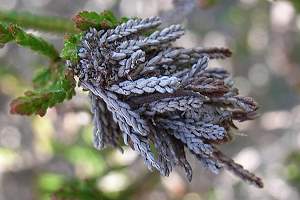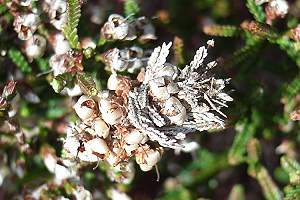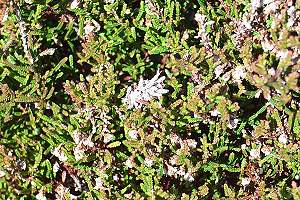

 +2Kontinente:EU
+2Kontinente:EU1. Lebendfotos
1.1. Falter
1.2. Raupe
2. Weitere Informationen
2.1. Etymologie (Namenserklärung)
Arnscheid & Weidlich (2021: 422) merken an, dass Bruand seine Tiere für die Erstbeschreibung von Pierre Joseph Michel Lorquin (1797-1873) erhielt.
2.2. Synonyme
- Psyche plumosella Bruand, 1853
2.3. Taxonomie
Arnscheid & Weidlich (2017) deuten weder bei der Gattungseinführung zu Ptilocephala noch bei der Besprechung der Ptilocephala albida an, dass da "noch etwas im Busch liegt". Arnscheid & Weidlich (2021) werten dann das bisherige Synonym Ptilocephala lorquiniella wieder zur Art auf und beschreiben die bisherigen südöstlichen "P. albida" als neue Art: Ptilocephala rutjani. Genetisch wurden beim Standard-Barcoding Unterschiede von 4 % zwischen P. lorquiniella und P. albida gefunden, bei einer innerartlichen Variabilität von P. lorquiniella von maximal 1 %. Bei P. rutjani liegen die Barcoding-Abstände zu P. albida und P. lorquiniella bei jeweils knapp 8 %.
2.4. Faunistik
Arnscheid & Weidlich (2017: 224) hatten zu den südwestlichen Vorkommen von "P. albida" geschrieben: "From Portugal (Corley, 2015), Spain (Vives Moreno, 2014: 64) and France (Leraut, 1997: 88) eastwards to [...]". Bei Arnscheid & Weidlich (2021: 421) verbleibt für P. albida dann nur noch: "P. albida is distributed from South France northwards to the Saarland [...]". Alle Angaben der Iberischen Halbinsel - nordwärts bis zu den Pyrenäen - werden der jetzt wieder als bona species angesehenen P. lorquiniella angesehen.
Zur Verbreitung von P. lorquiniella ist bei Arnscheid & Weidlich (2021: 421) zu erfahren: "The type locality of P. lorquiniella stat. rev. is not stated. But there is no doubt, that Bruand received the type specimen from Pierre Joseph Michel Lorquin (1797-1873), who collected them in Andalusia." Und weiter: "P. lorquiniella stat. rev. is probably distributed throughout the Iberian Peninsula (Portugal, Spain) north-eastwards to the Pyrenees. The distribution in the higher altitudes of the Pyrenees is still unclear. It also occurs in north-western Spain in the region of Galicia and it is striking that these populations are genetically more related to the populations of Andalusia than these to their next neighboring populations of Portugal. East of the Pyrenees it is most likely replaced by P. albida." Damit bleibt noch unklar, ob die Art in den Pyrenäen auch Frankreich erreicht. Das von uns bei P. albida gezeigte, von Pinker bei Cannes an der Mittelmeerküste Frankreichs gesammelte und als "P. lorquiniella" etikettierte Exemplar der Klimesch-Sammlung wäre nach diesen Aussagen fehlbestimmt gewesen - konkret Stellung zu diesem Exemplar nahmen die Autoren allerdings auch nicht.
2.5. Typenmaterial
Arnscheid & Weidlich (2021: 421) können nichts darüber mitteilen, ob die Syntypen von Bruand noch existieren und - falls ja - wo sie sich befinden.
(Autor: Erwin Rennwald)
2.6. Literatur
- Arnscheid, W.R. & M. Weidlich (2017): Psychidae. — In: Karsholt, O., Mutanen, M. & M. Nuss [edit.]: Microlepidoptera of Europe. Volume 8: 1-423; Leiden & Boston (Brill).
- Arnscheid, W.R. & M. Weidlich (2021): First taxonomic revision of the Ptilocephala albida-species group in Europe (Lepidoptera: Psychidae, Oiketicinae). — SHILAP Revista de lepidopterología, 49 (195): 417-433. [PDF auf redalyc.org]
- Erstbeschreibung: Bruand d’Uzelle, C.T. (1853): Essai monographique sur la tribu des Psychidae. — Mémoires de la Société libre d’Émulations du Doubs, (2) 3: 17-127.







